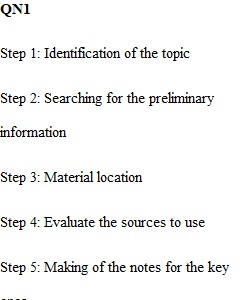


Q Please complete the following questions in an effort to brainstorm areas of research for your project. At the end, you will find a sample Annotated Bibliography citation and a form to help you gather all of the information you will need. It can easily work as a rough draft for your annotated bibliography. Please complete the following five (5) questions thoroughly and with as much specifics as possible, and fill out a Research Outline for each of your 4-5 sources. Research Prep Q/A 1) What research do you need to complete on the subject/topic of your project? 2) Where will you need sources to strengthen the ethos and/or logos of your paper? What area do you need to find to help bolster your credibility the most? 3) What research do you need to complete on the form/genre of your project? (I.E.: How to edit a podcast or revising a lyric essay, etc.) 4) Add a rough/estimated percentage to each category. If one category is 0%, please explain/justify. Topic Research: __________ % Form/Genre Research: __________% Justification: 5) Brainstorm Research Terms / Parallel Terms (Parallel research terms are useful when your research stagnates because of a lack of sources. In most cases, there is a better researched subject or topic that is closely related enough to be useful/useable. For example, while researching Peter Pan, I found little to no useful sources concerning the colonial, racist trope of “Tiger Lily” but the extensive research done on both John Wayne films & Pocahontas were plentiful and suitable for my research needs. While those sources did not mention Peter Pan, the information concerning Pocahontas and/or a more general example of the film industry’s use of the “Indian Princess” stereotype to support a “white savior” (male) protagonist was 100% applicable to the character of Tiger Lily.) What research terms and parallel terms might be relevant to your research? Sample Annotated Bibliography Entry Zarranz, Libe García. “Diswomen Stirke Back? In the Evolution of Disney’s Femmes in the 1990s.” Atenea, vol. 27, no. 2, 2007, pp. 55-65. Zarranz focuses on the obvious and subversive ways in which the corporation attempts to diversify. In the 90s, Disney animators shifted towards a more nuanced depictions of its feminine heroes. This serves as primary evidence for my claim that women and girls benefit from a broad range of representation on screen. This is another example of a media which might grant women/girls empowerment and emotional catharsis. This article will provide specific, critical observations from mass-media that I can incorporate as evidence to my primary argument to utilize the rhetorical appeals of ethos (from Zarranz herself) and logos (from her argument). Research Outline / Notes The notes should be the information that will remind you why you chose this source and primarily inform the annotation for your bibliography. What are you using the source for? How is it informing your project or process? Some of your sources may be largely irrelevant, but provide a single useful quote or piece of evidence. Some may function on multiple levels (informing process and topic or any other combination). Be sure to list any biases the source may contain, and how reliable it is as well. Most projects/topics can have a less reliable or biased source or two, so long as it is disclosed in the rhetoric. Entry One Title: Author: Keywords: Source (Website and search terms): Notes*: Entry Two Title: Author: Keywords: Source (Website and search terms): Notes*: Entry Three Title: Author: Keywords: Source (Website and search terms): Notes*: Entry Four Title: Author: Keywords: Source (Website and search terms): Notes*: Entry Five Title: Author: Keywords: Source (Website and search terms): Notes*: PreviousNext
View Related Questions